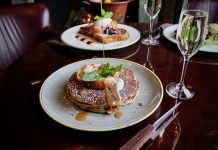By Linda Domingo | Photos by Jody Tiongco
“I started getting tattoos about the same time I started working in the kitchen, but the two aren’t really connected,” says Jonathan Blackford, executive chef of A Restaurant. Those who are familiar with the culinary industry may beg to differ. Walk into any restaurant’s kitchen and you’re bound to see at least one tattoo—there seems to be some sort of inextricable link between body art and the people who prepare our food.
“There’s a certain sense of camaraderie in the kitchen the same way you see people in the Navy with the same tattoos. I’m not comparing us to the military, but you see settings in which people are working closely in [an environment where the] level of intensity is high,” explains chef Andrew Gruel, CEO and founder of Slapfish. “It’s literally branding within the movement.”
Where soldiers might get tattoos of flags, division names, weapons and airplanes, chefs get condiments, French phrases, vegetables and the ubiquitous knife. It’s an expression of pride that’s not commonly seen in other industries, and a fascinating phenomenon to find hidden beneath white sleeves. “It’s an expression of art,” says Jeff Fernandez, junior sous chef at Bosscat Kitchen & Libations. “We consider ourselves artists, whether you’re a line cook or a culinary master. We express our skills every day through plating, with creativity.”
Still, some consider practical reasons many chefs have tattoos. “It’s a career where you’re hidden in the back, and it doesn’t really matter what you look like,” explains Nick Weber, executive chef at The Cannery.
Here, Newport Beach Magazine explores the connection between culinary professionals and tattoos—and exposes some of the city’s favorite chefs’ ink.
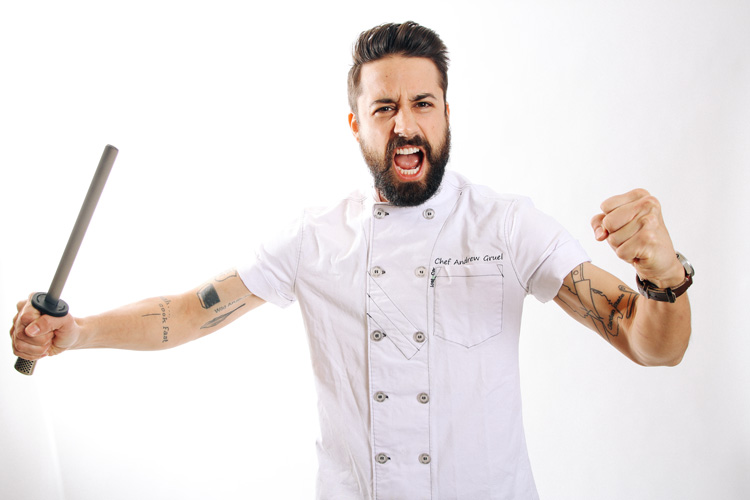
Body Art and Mayonnaise
Wild arugula, bluefin tuna, a Hellmann’s mayonnaise jar, a Heinz ketchup bottle, a Colman’s mustard jar: These are more than common items found in Slapfish kitchens; they’re also tattoos on the CEO and founder, chef Andrew Gruel. “I have a veritable pantry of sorts,” he says. He got his first tattoos in 1996 when he was 16 years old, but in 2005, the chef started his food ink collection with the mayo.
“I just really love condiments,” he continues. “… Everybody gets these tattoos and they take them so seriously, and they’re like, ‘This represents the sun and the moon and the stars,’ and I was like, ‘Look. All I ever want to do is eat.’ So I started a little condiment collection, then I moved up to bigger things like proteins with the fish, and then I got the wild arugula, so I got the salad in there.”
The chef has taken it further than food with the additions of a USDA Prime stamp, a rooster and a chef’s knife, his most recent addition. “I’ll keep moving along with the food theme,” he says of his future tattoo plans. “I’m thinking now, since we’re around the holidays, possibly a turducken, which is a turkey-duck-chicken [hybrid]—you throw it all in there.”
When asked when Slapfish fans will be able to see this masterpiece, Gruel laughs and admits he’s kidding. Or is he? “To be honest, I really haven’t thought about it.”
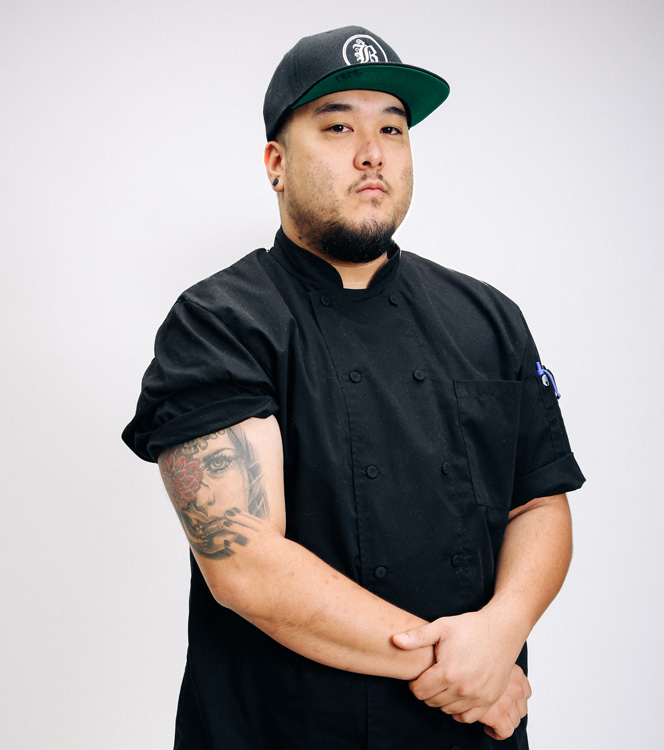
True Colors
While Gruel is less than serious about his food tattoos, Jeff Fernandez, kitchen line manager at Bosscat Kitchen & Libations, got permanently marked to show just how serious he is. “In the kitchen, we were talking about tattoos with John [Reed, the owner of the restaurant], and he goes, ‘What do you have? What do you have?’ pointing at each of us,” Fernandez says. “We all have a little something.”
The curiosity turned into a challenge. “He asks, ‘Who would get a Bosscat tattoo? I dare anybody to get a Bosscat tattoo,’” Fernandez adds. “He says that he’ll pay anybody a couple hundred bucks if they get a Bosscat logo tattoo.”
When a few staff members expressed interest, Reed upped the ante by offering $1,000 to the person who would get a tattoo with his likeness.
“We were slammed that night, but we kept talking about it for a couple hours while we were working,” Fernandez says. “So the next day, I wake up pretty early in the morning … and I called my tattoo artist.”
When Fernandez showed up at the restaurant with fresh ink, Reed was speechless and tried to rub the tattoo off his leg. “He held up his end of the bargain … about a week later,” Fernandez explains. “Now the bartenders and servers always have a story to tell.
“I’ve been here since day one; I’m in it for the long haul,” he continues. “I’ve worked in a lot of places, but this place is awesome. I see a big future in [this restaurant], so it doesn’t bother me. I’ve done crazier things.”
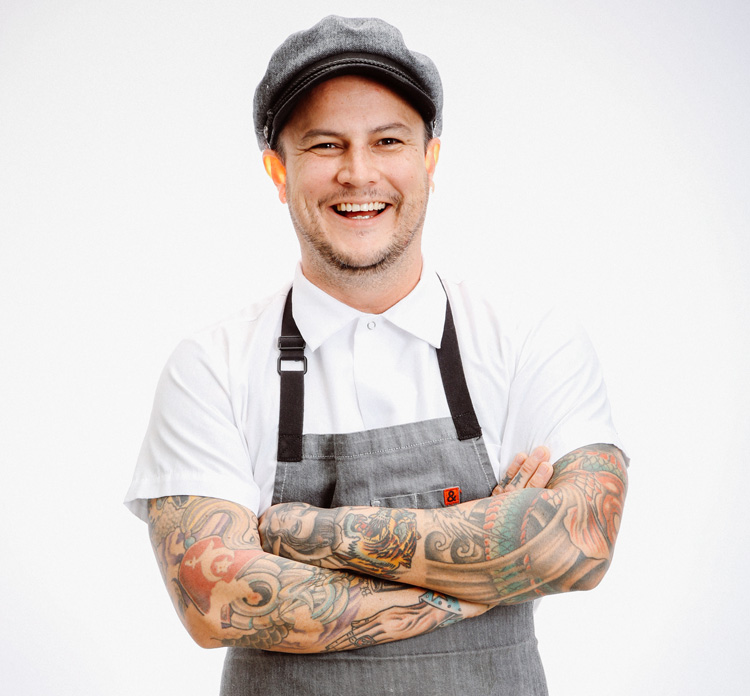
Of Days Gone By
Like Fernandez, chef Nick Weber at The Cannery has done crazier things. Before joining the waterside seafood restaurant, he was living a very different life in Las Vegas. He helped to open The Venetian hotel in 1999 and had already been in the industry for about six years. That dedication manifested itself in large tattoos of chef cleavers across his chest: “Those were the first food-related tattoos I got,” he says.
Weber explains the link between chefs and body art through his own experience. “It’s a rock ’n’ roll job,” he says. “I used to be that guy, but now I have kids and a family, so it’s not me anymore. You work all day and you go out and party hard, then show up for work the next day and do it all over again. Especially when I lived in Vegas, that was the lifestyle.”
Remnants of that lifestyle can still be seen all over the chef, as he continues to add to his collection of tattoos. When California banned foie gras in 2012, Weber got “FOIE GRAS” tattooed across his knuckles in Old English lettering. He has a martini on his pinky. There’s also a black flag inside a coffee cup on his arm to represent one of his favorite songs, “Black Coffee” by Black Flag.
“A while back, I got a snail on my side, but it’s like a cholo snail—like ‘ese-cargot,’ ” he laughs. “I came up cooking French bistro food and brasserie food, so I thought I’d get an escargot tattoo, but I wanted it to be an ‘ese-cargot.’ ”
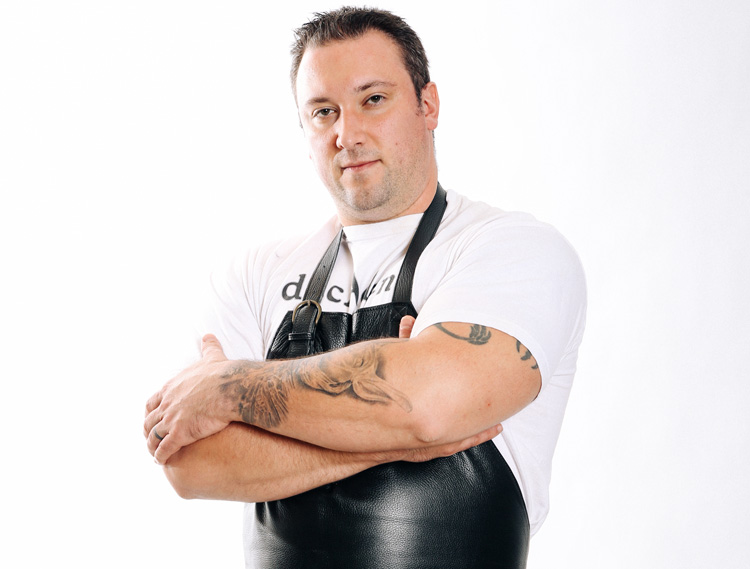
Milestone Markings
Just as Weber marked his immersion in the culinary world with cleaver tattoos, A Restaurant Executive Chef Jonathan Blackford marks a milestone with his ink. He counts about 11 or 12 tattoos on his body, the magnum opus being a sleeve of culinary images that the chef decided to get to commemorate his 20th year of cooking in 2016.
“I have different tattoos for different points in my life,” he says. “I finally decided, OK, I’ve got to do something for cooking.” On his arm, a large pig’s head, a burner, a chef’s knife and a bone-in rib-eye all sit adjacent to the words “chez moi.”
The tattoo represents the cooking process: the raw product (the pig’s head), how to clean the product (the chef’s knife) and how to cook the product (the burner). The words describe Blackford’s cooking philosophy. “It’s a French term meaning ‘where we are,’ ” he adds. “… We try to get local ingredients from local purveyors and fit the theme of California cooking.”
The ink has been a labor of love that Blackford started in early 2015. Each component takes about four to five hours; he expects to complete the piece in December. And once it’s done, diners will likely be able to see the project if they catch a glimpse of the chef; he won’t be hiding it. “For a long time, I didn’t get [tattoos] on my arms, because I know that you might be judged in certain cases,” he explains. “I would say 10 years ago, if I was applying to a high-end hotel it would not have helped me. … Now I have my wedding ring tattooed on me, and you can’t hide that.”



